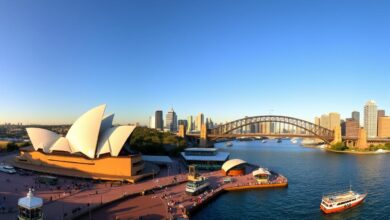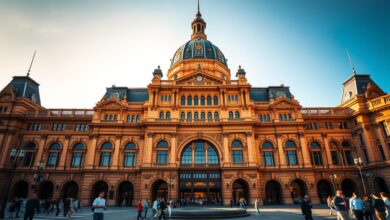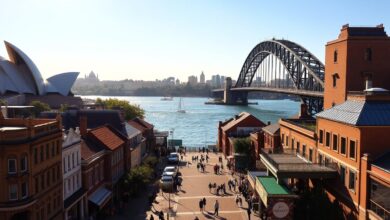The Sydney Opera House is a symbol of Australia’s rich culture. Its innovative architecture makes it a modern design masterpiece.
The Opera House’s shell-like design is not just beautiful. It also helps with sound quality during shows. The use of natural light adds to its stunning look.
Key Takeaways
- The Sydney Opera House is an iconic symbol of Australia.
- Its innovative architecture has made it a masterpiece of modern design.
- The building’s shell-like structures provide excellent acoustics.
- Natural light is incorporated into the building’s design.
- The Opera House is a testament to Australian creativity and innovation.
The Vision Behind the Sydney Opera House
The Sydney Opera House was built to be more than a venue for shows. It was meant to symbolize Australian identity. The building’s design reflects the country’s culture and its urban setting.
Jens Otto Henriks Syddan’s Inspiration
Jorn Utzon, the Danish architect, was inspired by many things, including ship sails. His use of concrete and the white shell design are key to the building’s look. Utzon’s travels and interest in design and function shaped his work.
“The Sydney Opera House is a masterpiece of modern architecture, not just because of its striking design, but also due to its ability to integrate with its surroundings.”
The Role of Urban Landscape
The Opera House sits on Bennelong Point, blending nature with city life. Its design respects the landscape, creating a balance. It’s a key part of Sydney’s cityscape.
Importance of Australian Culture
The Sydney Opera House is more than a venue; it’s a cultural symbol. It showcases a variety of performances, from opera to concerts. It reflects Australia’s values and love for the arts.
| Cultural Significance | Architectural Innovation | Impact on Tourism |
|---|---|---|
| Represents Australian heritage | Innovative use of concrete | Attracts millions of tourists |
| Hosts various performances | Iconic white shell design | Boosts local economy |
The Sydney Opera House shows the power of design in shaping a nation’s identity. Its cultural and architectural importance make it a standout landmark.
Architectural Features That Captivate
The Sydney Opera House is famous for its shell-like roof. It’s a modern architectural wonder. The design is not just beautiful but also uses new construction methods.
Unique Shell-Like Structures
The Sydney Opera House is known for its unique shell-like structures. These are made from over 2,194 pre-cast concrete sections. They were cast on site using a special mould.
This method allowed for the complex roof design. It’s both stunning and strong.
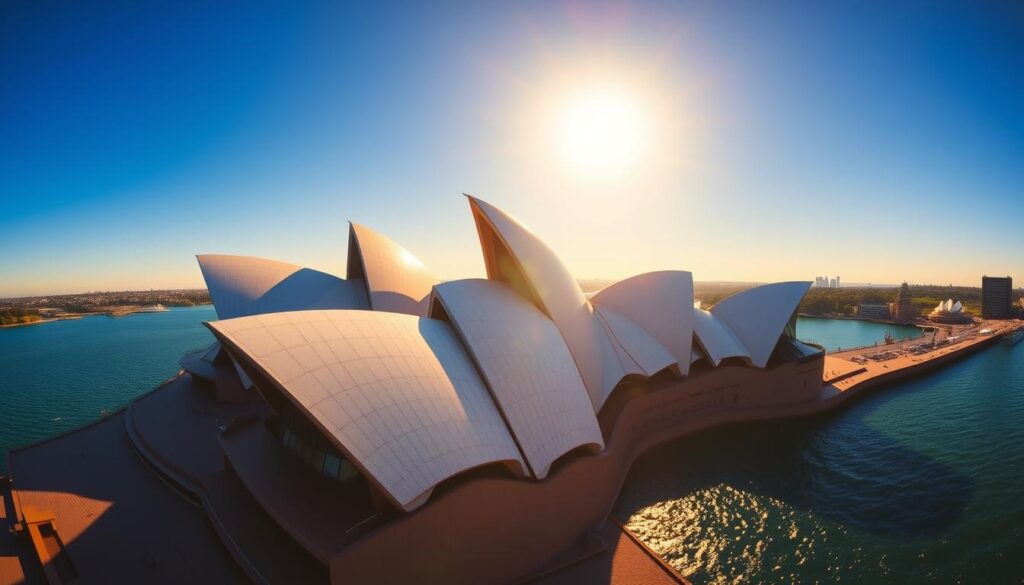
Use of Innovative Materials
The Sydney Opera House was built with innovative materials like concrete and glass. These materials make the building strong and look great. Concrete helped create the building’s unique shapes.
Impact of Natural Light
The Sydney Opera House is special because of how it uses natural light. It has big glass panels and clerestory windows. This lets natural light fill the halls and foyers.
This makes the place look better and cuts down on the need for artificial light.
| Feature | Description | Benefit |
|---|---|---|
| Shell-Like Structures | Made up of over 2,194 pre-cast concrete sections | Visually striking and structurally sound |
| Innovative Materials | Use of concrete and glass | Durable and aesthetically pleasing |
| Natural Light | Large glass panels and clerestory windows | Enhances aesthetic experience and reduces artificial lighting needs |
The Engineering Marvel of the Opera House
The Sydney Opera House is more than just a beautiful building. It’s a story of engineering brilliance. Building it was a huge challenge that needed new ideas and exact planning.
Challenges Faced During Construction
Building the Sydney Opera House was tough. The roof’s complex shape and interlocking concrete panels were a big problem. Keeping the structure stable and strong was key.
Engineers had to find new ways to make the roof work. They used advanced calculations and new materials and methods.
Techniques Used in the Design
The Opera House’s design was ahead of its time. It used computer-aided design (CAD) for detailed and complex designs.
The roof’s use of precast concrete was a big step forward. It made it possible to build the unique roof shapes.
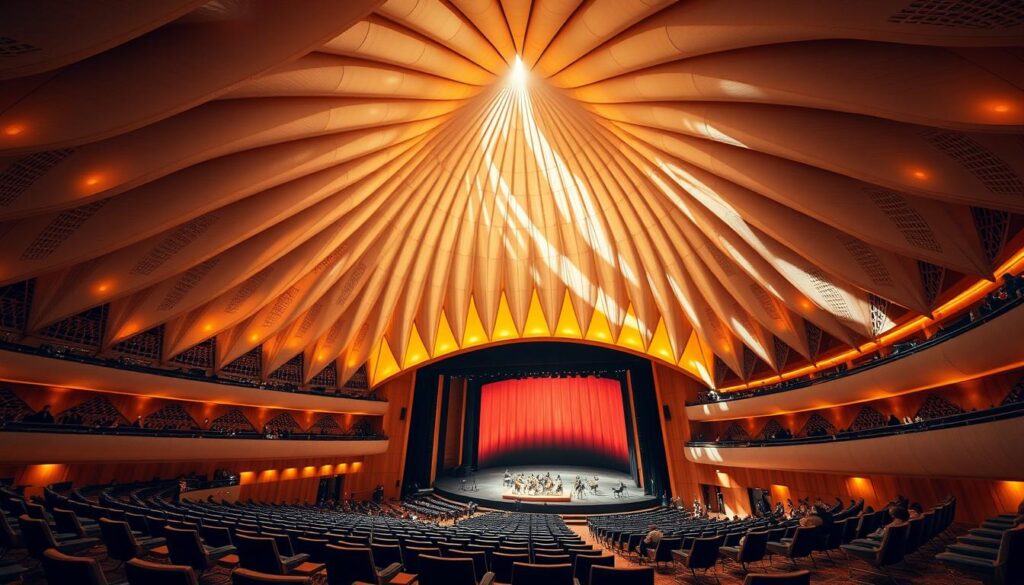
Contribution of Structural Engineers
Structural engineers were vital in making the Opera House real. They worked with architects to make sure the design was both beautiful and strong.
The team’s work made the Opera House both stunning and practical. The engineers’ efforts were key to solving the many construction problems.
| Engineering Challenge | Solution Implemented |
|---|---|
| Complex Roof Geometry | Advanced CAD and precast concrete |
| Structural Stability | Innovative foundation design and precise construction techniques |
| Durability and Maintenance | Use of high-quality materials and sustainable practices |
The Journey from Concept to Completion
Jorn Utzon’s winning design started the Sydney Opera House’s long journey. The path was filled with challenges and needed many hands to finish.
Initial Design Competition
The Sydney Opera House’s design competition was a key moment. In 1956, over 233 architects from around the world entered. Jorn Utzon’s design stood out for its bold and new ideas.
Key Milestones in Construction
The Sydney Opera House’s construction had many important moments. It started in 1959, with a focus on the podium and the roof. The roof’s shape was tricky to build, needing new engineering ideas.
- 1959: Construction begins
- 1962: Roof construction commences
- 1967: Roof completed
- 1973: Sydney Opera House officially opens
The Role of Government Support
Government support was key for the Sydney Opera House. Despite many hurdles and cost increases, its cultural importance won over funding.
| Year | Milestone | Significance |
|---|---|---|
| 1956 | Design competition announced | Attracted international attention and entries |
| 1959 | Construction begins | Marked the start of a complex construction process |
| 1973 | Sydney Opera House officially opens | Completed after numerous challenges and delays |
The Sydney Opera House’s journey shows Jorn Utzon’s architectural legacy. It also highlights the teamwork of many people and groups.
Cultural Significance of the Sydney Opera House
The Sydney Opera House is more than a building; it’s a cultural icon. It shows the spirit of Australia. It’s a symbol of the country’s creativity and innovation.
A Symbol of Australia
The Sydney Opera House is like a symbol of Australia. It’s as famous as the Eiffel Tower in Paris or the Statue of Liberty in New York. Its unique design makes it easy to spot.
It’s not just a building; it represents Australian culture and values. It’s featured in many films, photos, and artworks.
Hosting International Events shows the Opera House’s cultural importance. It hosts various performances and events all year. These include opera, ballet, and music concerts.
These events draw visitors from everywhere. They help the local economy and promote cultural exchange.
Influence on Tourism
The Sydney Opera House greatly impacts tourism in Sydney. Millions visit each year, making it a top attraction. The area around it has been improved for visitors.
There are public spaces, restaurants, and tours available. This makes the experience better for everyone.
| Year | Number of Visitors | Events Hosted |
|---|---|---|
| 2018 | 8.2 million | 40 major events |
| 2019 | 8.5 million | 45 major events |
| 2020 | 7.8 million | 38 major events |
The Sydney Opera House is more than a cultural icon. It drives tourism and economic growth. Its impact goes beyond culture, helping the local community and economy.
Sustainable Practices in Its Design
The Sydney Opera House is a symbol of sustainable design. It shows a strong commitment to protecting the environment. The building’s design uses sustainable practices to reduce its environmental impact and improve its function.
Environmental Considerations
The Sydney Opera House was built with the environment in mind. Its unique design, like a sail, was not just beautiful but also saved materials. Using local materials for construction also cut down on transportation’s environmental harm.
Key Environmental Initiatives:
- Use of locally sourced materials
- Minimization of construction waste
- Incorporation of natural ventilation systems
Energy Efficiency Measures
The Sydney Opera House has many ways to save energy. It uses energy-efficient lights and HVAC systems. The building also lets in lots of natural light, cutting down on the need for artificial light.
| Energy Efficiency Measure | Description | Impact |
|---|---|---|
| Energy-Efficient Lighting | Installation of LED lighting throughout the building | Significant reduction in energy consumption |
| HVAC Systems | High-efficiency heating, ventilation, and air conditioning systems | Improved indoor air quality and reduced energy use |
| Natural Light Maximization | Strategic placement of windows and skylights | Reduced need for artificial lighting |
Future-Proofing the Structure
Future-proofing the Sydney Opera House means making it ready for the future. It involves adding new technologies and materials. These changes will make the building more energy-efficient and environmentally friendly.
The Sydney Opera House keeps getting better at being sustainable. It keeps finding new ways to be green. This makes it a lively cultural center while being kind to the planet.
The Ongoing Legacy of the Opera House
The Sydney Opera House is a symbol of Australian culture. Its influence goes beyond its stunning design. Jorn Utzon’s innovative design techniques inspire architects all over the world.
Restoration and Upgrades
Restorations and upgrades keep the Opera House looking great. They preserve its charm while adding modern touches for sustainability.
Influence on Architecture
The Opera House’s design has changed architecture forever. Its shell-like shape and use of materials inspire architects today.
Community Engagement
The Sydney Opera House supports the arts and culture. It runs community programs and educational activities. This shows its key role in Australian culture.
FAQ
Who designed the Sydney Opera House?
The Danish architect Jorn Utzon designed the Sydney Opera House. He won the international design competition in 1957.
What inspired the design of the Sydney Opera House?
The design was inspired by ship sails and Sydney’s urban landscape. It also reflects the cultural importance of the site.
What are the unique features of the Sydney Opera House’s architecture?
The Sydney Opera House is famous for its shell-like roof. It also uses innovative materials like concrete and glass.
How has the Sydney Opera House influenced Australian culture?
It’s a symbol of Australia and a source of national pride. It hosts international events and performances, drawing visitors worldwide.
What sustainable practices have been incorporated into the Sydney Opera House’s design?
The Sydney Opera House includes sustainable features. These include environmental considerations and energy efficiency to protect the structure for the future.
How has the Sydney Opera House contributed to the tourism industry in Sydney?
It has greatly influenced Sydney’s tourism. Millions visit each year for its performances, festivals, and architecture.
What is the significance of the Sydney Opera House in the world of architecture?
It’s seen as an architectural masterpiece. It has inspired architects with its innovative design and material use.
What restorations and upgrades have been made to the Sydney Opera House?
The Sydney Opera House has seen several restorations and upgrades. These ensure the building remains in top condition, including renewed performance halls and improved facilities.
